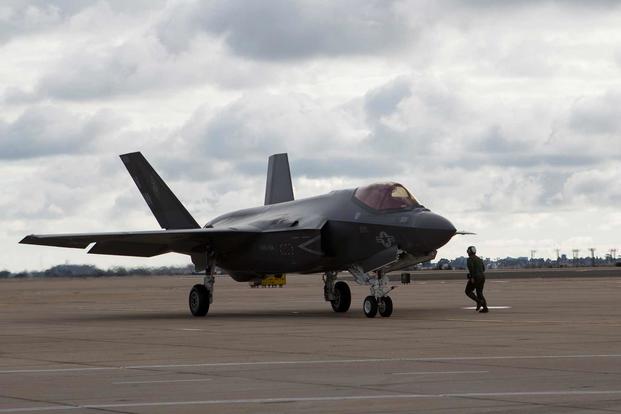A California-based Marine Corps squadron has received its first F-35C Joint Strike Fighter jet, which can fly off aircraft carriers and make longer-range flights.
Lt. Col. Cedar Hinton, commanding officer of Marine Fighter Attack Squadron 314, flew the next-generation Lightning II fighter jet to Marine Corps Air Station Miramar on Tuesday.
The Marine Corps has carried out flight operations in the "B" variant of the F-35, which can take off and land vertically on amphibious assault ships, since 2015. This is the first time a Marine squadron has had a "C" variant, which is designed for carrier operations.
VMFA-314, known as the "Black Knights, was the first squadron in the Navy Department to fly the F/A-18 Hornet jet in the 1980s. The squadron was also the first to transition to the F-4B Phantom ground-attack aircraft in 1961, and the "Black Knights" were the first members of 3rd Marine Aircraft Wing to transition to jet aircraft in 1952 and fly the F-9F Panther.
Related: Navy Achieves New F-35 Fighter Jet Milestone on USS Carl Vinson
"It should be no surprise that VMFA-314 is once again leading the way into the next generation of fighter attack aircraft," Hinton said in a statement after landing the F-35C at Miramar.
Lockheed Martin, which manufactures the F-35, calls the "C" variant "the only fighter that can respond to tomorrow's threats and preserve the U.S. Navy's maritime supremacy." Of the three Joint Strike Fighter variants, the F-35C can carry the most internal fuel -- nearly 20,000 pounds -- which allows for longer range.
It can also refuel in-flight, which Lockheed says "allows the Navy to operate its carriers a safe distance from the threat while its fighters reach remote targets."
The Navy is working toward getting its fleet of carriers equipped for F-35C deployments.
The F-35C completed its fleet carrier qualifications on the carrier Abraham Lincoln in 2018. The aircraft is scheduled to make its first upcoming sustained deployment aboard the carrier Carl Vinson, Capt. Danny Hernandez, a Navy spokesman at the Pentagon, said.
The Nimitz-class and Ford-class carriers can, by design, operate with F-35Cs, he added, but the ships need to be modified to support full-length deployments. Changes include additional spaces, jet-blast deflectors and other requirements unique to the F-35.
None of the modifications require fundamental redesigns to any major components of the ship, Hernandez said.
The Navy was planning to time those changes for both carriers already in-service and those under construction ahead of scheduled operational F-35C deployments. The 2020 National Defense Authorization Act, however, which the president recently signed into law, mandated those changes be made to the carrier John F. Kennedy -- the second of the Ford-class carriers -- before completing the post-shakedown availability. That's when problems identified during sea trials and shakedown are fixed.
The next two Ford-class carriers in line -- the Enterprise and Doris Miller -- will receive those changes during construction and will not require a post-delivery modifications, Hernandez said.
-- Gina Harkins can be reached at gina.harkins@military.com. Follow her on Twitter @ginaaharkins.
Read more: Marine F-35s Dropped a Bunch of Bombs on ISIS During 1st Middle East Deployment












